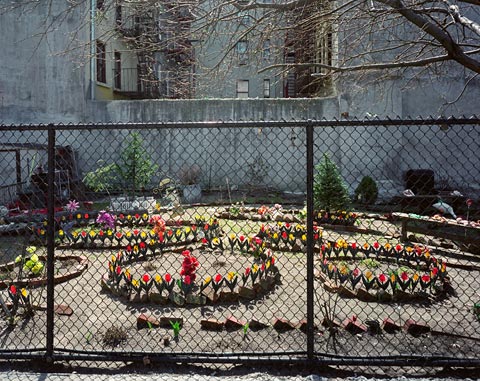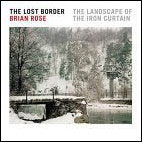Monday, April 30, 2007
Thursday, April 26, 2007
Tuesday, April 24, 2007
New York/Ground Zero/Potsdamer Platz
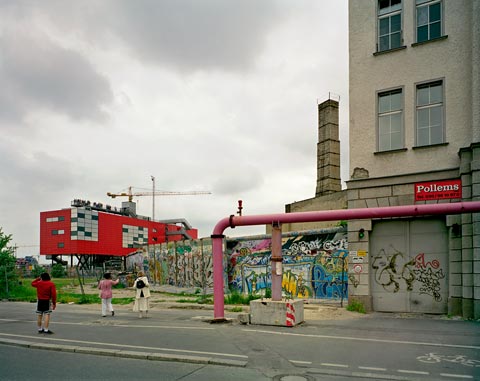
InfoBox and Berlin Wall, 1996 (4x5 film)
In the previous post I compared Potsdamer Platz in Berlin and ground zero (WTC) in New York. Both are historically sensitive places in which rebuilding symbolizes attempts at reclaiming loss. Both entail large commercial development, and both include memorials, either at the heart of the effort as in New York, or nearby as in Berlin. In Berlin the millions of tourists who came to view the vast rebuilding site were welcomed at the InfoBox, a temporary structure housing models, renderings and multimedia presentations, and on the roof, a deck for surveying the new architecture rising on the skyline.
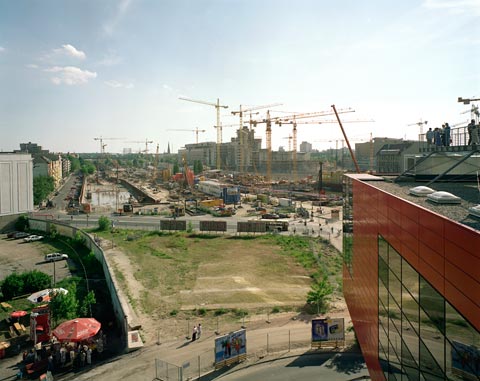
InfoBox and Potsdamer Platz, 1996 (4x5 film)
The InfoBox was designed by Schneider + Schumacher, an architecture firm based in Frankfurt. From their website:
The commission for the InfoBox was the outcome of an invited competition in 1994. The aim was to design a building which would reflect the worldwide interest in the building activities on Potsdamer Platz in the recently re-united Berlin.
The box was concise and easily identified, hovering on stilts above the surrounding chaos, at the time the largest construction site in Europe. It was a simple yet powerful gesture.
In October 1995 the InfoBox opened and in very short time attracted a large audience, welcoming its four millionth visitor in February 1998. In january 2001 this temporary building was disassembled according to plan.
There is no comparable facility in the works for the World Trade Center site. Tourists wander aimlessly trying to grasp the scope of what was and what is to come. There is a small museum, nicely designed, but inadequate to the task. There are photos bolted up high on the metal grating around the Path station--though those are now coming down to make way for the relocation of the station. At the present, most visitors are interested in views into the bathtub, the pit formed by the foundation walls left after the site was cleared of debris that contained the remains of those who died there. There are a few places that afford views: an area under the sidewalk shelter in front of the Deutsche Bank building, which is now being torn down. The pedestrian bridges spanning West Street--very awkward places to stand. The glass wall at the back of the Winter Garden in the World Financial Center--good for an overall vista, but not high enough or close enough to see into the bathtub. That's basically it.
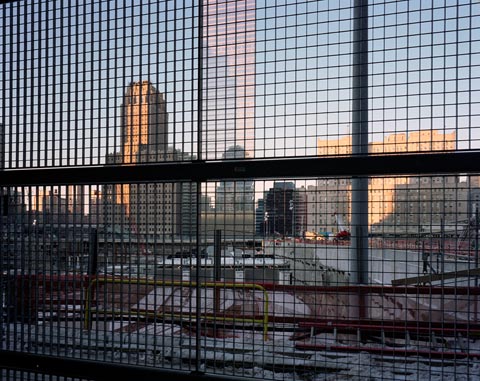
Steel fence in front of Deutche Bank building, (4x5 film)
Ground zero is in great need of an InfoBox of its own, a structure built well above street level with an outdoor viewing promenade. It should contain the models and multimedia now available only on the various websites relating to the WTC. Even on the Internet there is no single clearing house of reliable information. The Port Authority has a website. Larry Silverstein, the developer, has one, and the Lower Manhattan Development Company (LMDC) has two including an informational site called LowerManhattan.info. There are others.
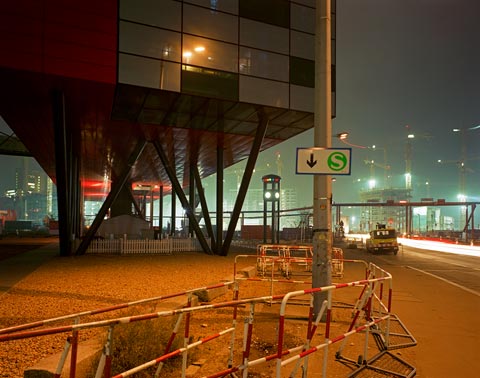
Under the InfoBox, 1999 (4x5 film)
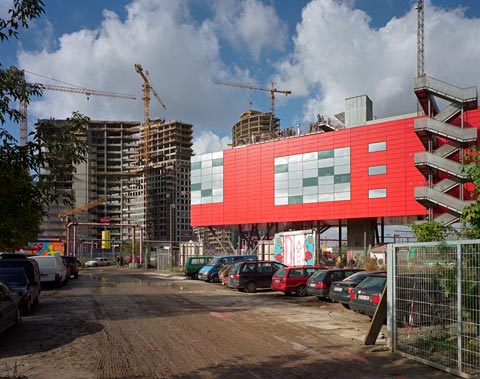
InfoBox, 1999, (4x5 film)
This lack of focus and scatter-shot approach to disseminating information is, of course, evidence of the chaos created by competing agendas, financial interests, and governmental agencies plagueing the whole project. But despite all of that, it would seem possible for the city, state, Port Authority, and Larry Silverstein, to come together to create an Infobox-like center on the site. There is more than enough space for such an elevated temporary structure. Even as the 9/11 memorial takes shape, it will be years before the spiral of buildings that loosely follow the original Libeskind plan will be completed. During that construction period, millions of tourists from around the world need to be accomodated. Ultimately, an information center/observation deck would do more than that. It would help demonstrate that the city is looking to the future with confidence in the wake of the attacks on 9/11.
Monday, April 16, 2007
New York/Ground Zero/Potsdamer Platz
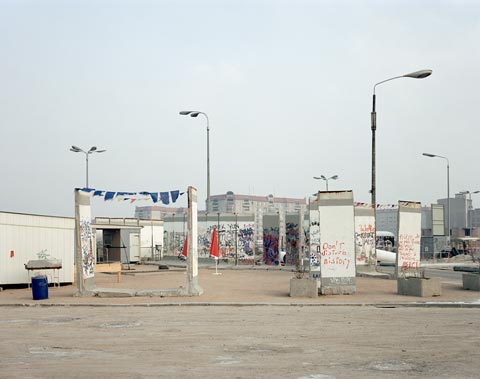
Wall fragments at Potsdamer Platz, 1990 (4x5 film)
As I wrote in an earlier post, ground zero (the World Trade Center site) reminds me of Potsdamer Platz in Berlin during the great wave of construction that occurred in the 1990s after the fall of the Berlin Wall. Although the circumstances leading to the two rebuilding efforts are obviously different, both were and are of intense interest to the public.
The reclamation of Potsdamer Platz was not just about the unification of Germany. It represented a new beginning reaching back to the zero hour (Stunde Null) at the end of World War II with its landscape of destruction. This no man’s land at the center of the city lay in limbo through the Cold War years, bisected by the Wall, and symbolized the unreconciled issues concerning the destiny of Germany and Europe, the Holocaust, and the role of Berlin as the historical metropolis at the crossroads of east and west.
The destruction of the World Trade Center and the death of nearly 3,000, while uniquely horrific, pales in comparison to the losses of World War II. Nevertheless, it created a trauma in human and political terms that cannot be underestimated for New York and the rest of the world.
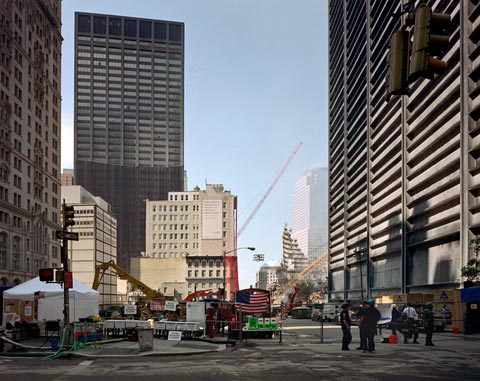
Ground zero seen from Broadway two weeks after the attack, 2001 (4x5 film)
In both Berlin and New York, the erasure of important symbols led to an immediate desire to rebuild. I won’t debate here the merits of the impulse to reclaim the image of the Twin Towers, or the wish of some to treat all of the WTC site as hallowed, therefore untouchable, ground. But there can be little doubt, that the public favored some combination of memorialization and the restoration of a heroic icon on the city’s skyline. With great fanfare a plan was selected, and despite all the compromises–some crippling–construction is now taking place. In fact, WTC 7 has aleady been rebuilt, an elegant glass tower, hovering over a vast chaotic tableau of yet unrealized plans.
In Berlin millions came to witness the rebuilding of Potsdamer Platz, and participate in the debate surrounding the plans of the architects who became household names in Germany and abroad. Many of the architects who were active at that time in Berlin–Libeskind, Piano, Rogers, Foster, Calatrava–are now similarly employed in New York affirming a post-9/11 recognition of the role of architecture in civic life.
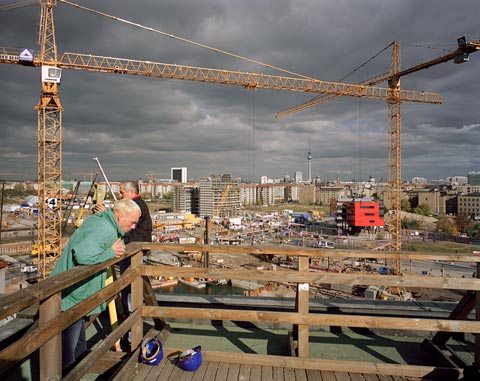
Potsdamer Platz construction with red InfoBox, 1996 (4x5 film)
The public’s passion for the rebuilding of Potsdamer Platz was properly understood in Berlin, and a temporary structure was erected in the midst of the site housing the models, drawings, and videos. The InfoBox, as it was called, also featured an elevated deck for surveying the surrounding urban forest of construction cranes. The InfoBox became the destination for the droves of tourists who otherwise would have wandered aimlessly about the site looking for views while trying to make sense of what was going on.
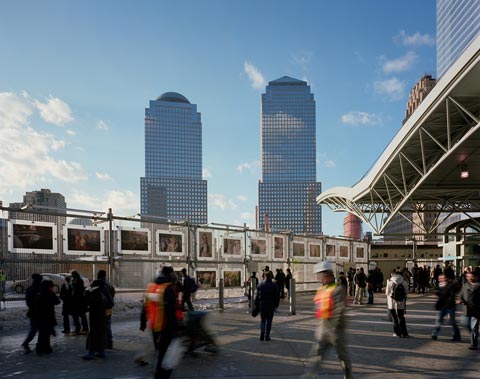
Ground zero visitors and commuters, 2007 (4x5 film)
This, alas, is the present situation at ground zero in New York.
To be continued…
Wednesday, April 11, 2007
New York/South Street
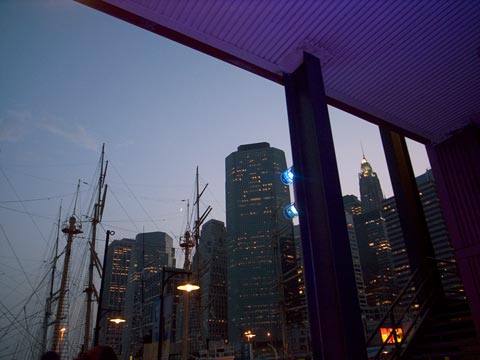
South Street, Fulton Fish Market, mid-1980s (4x5 transparency)
Going through my archive the other day, I came across this image of the former Fulton Fish Market on South Street in Lower Manhattan. The market was moved for a variety of reasons, the most important of which, was the requirement that it be in a refrigerated, sanitary, environment. South Street failed in that regard. Neither did it offer easy access for the trucks that long ago supplanted fishing boats as the main conveyance for bringing in fresh fish. The new market is at Hunt's Point in the Bronx.
Things change--and are changing--rapidly in the city for better or for worse. The Fulton Fish Market was a vestige of an earlier Manhattan where related businesses congregated together. A few posts down I wrote about the transformation of the Meatpacking District. One by one, these marketplaces are disappearing. The garment district with its racks of clothing on the sidewalk is a shadow of its former self. The flower district is threatened. The restaurant supply row along the Bowery near my office is probably on its last legs. Orchard Street, once a lively bazaar with goods spilling onto the street on Sundays, is now mostly quiescent.
I haven't anything particularly profound to say about all this. As a photographer of the city I note the passing of things and move on to the next wave of activity. But certainly, some of this progress comes at our loss.
Friday, April 06, 2007
New York/MoMA and Brendan

Brendan at the Museum of Modern Art
Went to MoMA yesterday with inlaws from Holland. Brendan, son, announced as we entered the museum that he didn't like art, and then proceeded to go from painting to painting talking up a storm about the colors, lines, images, commenting about one Paul Klee that it appeared that the artist painted layers of color and then scratched into paint revealing underlying colors. He then stood in front of a Jackson Pollock drip painting and compared it to a Roadrunner cartoon in which the Roadrunner zipped above and the Coyote ran below criss-crossing each other repeatedly. He liked Broadway Boogie Woogie by Mondrian, and particularly appreciated the many Picassos on view in the galleries. Also, he liked the Helen Levitt street images in the photography gallery.
At 8, I hadn't even visited a musuem.


